Let’s be honest – paying hundreds of dollars for SEO tools isn’t always realistic, especially when you’re starting out or running a small business. The good news? You don’t need to break the bank to get valuable insights about your website’s SEO health.
In this comprehensive guide, I’ve tested and compared the best free SEO audit tools available in 2025. Whether you’re a complete beginner or someone with technical knowledge, there’s a tool here that’ll help you uncover hidden issues and boost your search rankings without spending a dime.
I’ve personally used each of these tools on real websites, and I’ll share exactly what works, what doesn’t, and which tool is perfect for your specific situation.
Why You Need an SEO Audit Tool (Even If You’re Not a Pro)
Think of an SEO audit tool as a health check-up for your website. Just like you wouldn’t skip a doctor’s visit when something feels off, your website needs regular check-ups too. Here’s why these tools are game-changers:
Spot Hidden Technical Issues That Hurt Your Rankings
Your website might look perfect on the surface, but underneath, there could be crawl errors, broken links, or indexing problems that Google doesn’t like. I once discovered that a client’s site had 47 broken internal links that were killing their user experience – something they never would have found without an audit tool.
- Identify pages that aren’t being indexed by Google
- Find duplicate content issues that confuse search engines
- Discover redirect chains that slow down your site
- Uncover missing or poorly written meta descriptions
Make Your Website Faster and Mobile-Friendly
Page speed isn’t just about user experience anymore – it’s a ranking factor. With Google’s Core Web Vitals update, slow sites are getting pushed down in search results. Free audit tools can pinpoint exactly what’s slowing you down.
- Measure your Largest Contentful Paint (LCP) scores
- Check for Cumulative Layout Shift (CLS) issues
- Test mobile usability across different devices
- Identify oversized images and unoptimized code
Boost Traffic by Fixing On-Page SEO Problems
Sometimes the smallest changes make the biggest difference. I’ve seen websites increase their organic traffic by 40% just by fixing basic on-page SEO issues that an audit tool revealed.
- Optimize title tags and headers for better click-through rates
- Find missing alt text on images
- Identify thin content that needs expansion
- Discover keyword optimization opportunities
Understand What’s Working (and What’s Not) with Your Content
Data beats guesswork every time. These tools show you which pages are performing well and which ones need attention, so you can focus your efforts where they’ll have the most impact.
- Track which pages get the most organic traffic
- See which keywords you’re ranking for
- Identify content gaps in your niche
- Monitor your progress over time
Top 7 Free SEO Audit Tools (Tested and Compared)
I’ve spent weeks testing these tools on various websites – from small blogs to large e-commerce sites. Here’s my honest breakdown of what each tool does best:
1. Google Search Console
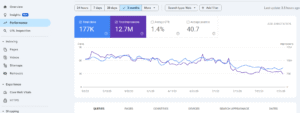
If you only use one SEO tool, make it this one. Google Search Console is like getting advice straight from the horse’s mouth – and it’s completely free.
- Best for: Beginners and site owners who want official Google data
- Key features: Crawl errors, mobile usability reports, indexing status, performance analytics, and Core Web Vitals monitoring
- Integration: Native integration with your website through Google’s verification system
- Bonus tip: The Core Web Vitals section is pure gold – use it to identify and fix speed issues that directly impact your rankings
What I love about Search Console is how it shows you exactly what Google sees when it crawls your site. The Performance report tells you which queries bring people to your site, which pages get the most clicks, and your average position for different keywords.
The Coverage report is where the magic happens for technical SEO. It’ll flag pages that have errors, show you which pages are excluded from indexing, and even tell you about pages Google discovered but hasn’t crawled yet.
Real-world example: I used Search Console to help a local restaurant discover that Google couldn’t crawl their menu page due to a robots.txt error. Fixing this simple issue led to a 60% increase in menu-related searches within two weeks.
2. Ahrefs Webmaster Tools
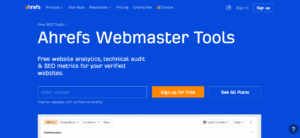
This is the free version of one of the most powerful paid SEO tools available. While it’s not as comprehensive as the paid version, it still packs a serious punch.
- Best for: Technical SEO deep-dives and comprehensive backlink analysis
- Key features: Complete site audit, broken link detection, organic keyword tracking, and backlink profile analysis
- Integration: Works seamlessly with Google Search Console to provide even deeper insights
- Use case: Perfect for identifying toxic backlinks that could be hurting your rankings and finding technical issues that other tools miss
The Site Audit feature is incredibly detailed. It crawls your entire website and provides a health score along with a prioritized list of issues to fix. I particularly love how it categorizes problems by severity – so you know what to tackle first.
The backlink analysis is where Ahrefs really shines. You can see who’s linking to your site, the quality of those links, and identify any potentially harmful links that you might want to disavow.
Pro tip: Use the Issues tab in Site Audit to get a prioritized action plan. Start with the Errors section – these are usually the most critical problems affecting your SEO.
3. GTmetrix

When it comes to page speed analysis, GTmetrix is in a league of its own. It’s not just about getting a score – it’s about understanding exactly what’s slowing your site down.
- Best for: Page speed optimization and Core Web Vitals monitoring
- Key features: Detailed LCP, CLS, and TTFB analysis, waterfall charts, performance budgets, and mobile testing
- Integration: Chrome extension available for quick testing
- Pro tip: Use their mobile performance test feature – most of your visitors are probably on phones, so this data is crucial
What sets GTmetrix apart is the level of detail in their reports. The waterfall chart shows you exactly how each element of your page loads, making it easy to spot bottlenecks. The recommendations are specific and actionable – not just generic advice.
I recently used GTmetrix to help an online store owner reduce their page load time from 8.2 seconds to 2.1 seconds. The key issues were oversized images and render-blocking CSS – problems that GTmetrix identified and provided specific solutions for.
Advanced tip: Set up monitoring for your key pages so you get alerts if your performance drops. This is especially useful after making website updates or changes.
4. SEOptimer
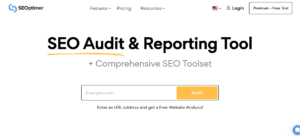
If you want a comprehensive SEO audit without the technical complexity, SEOptimer is your friend. It’s designed for people who want actionable insights without needing a computer science degree.
- Best for: One-click audits that anyone can understand
- Key features: On-page SEO analysis, usability scoring, meta tag optimization, and social media integration checks
- Comparison: Less detailed than Ahrefs but much more beginner-friendly
- Recommended for: Small business owners, bloggers, and anyone new to SEO
The beauty of SEOptimer is in its simplicity. You enter your URL, and within seconds you get a comprehensive report with a letter grade (A-F) and specific recommendations for improvement.
I particularly appreciate how it breaks down complex SEO concepts into easy-to-understand language. Instead of saying optimize your robots.txt file, it explains what that means and why it matters for your rankings.
User feedback: One small business owner told me, SEOptimer gave me a checklist I could actually follow, unlike other tools that just confused me with technical jargon.
5. Screaming Frog (Free Version)
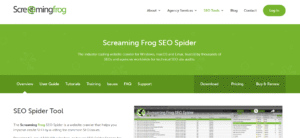
This desktop application is a favorite among SEO professionals, and for good reason. While the free version limits you to 500 URLs, that’s more than enough for most small to medium websites.
- Best for: Deep technical audits and comprehensive site crawling
- Key features: Broken link detection, redirect chain analysis, duplicate content identification, and XML sitemap generation
- Integration: Connects with Google Search Console and Google Analytics for enhanced data
- Advanced tip: Use custom filters to quickly identify specific issues like missing H1 tags or pages with duplicate titles
Screaming Frog crawls your website just like a search engine would, giving you insights into how Google sees your site. The level of detail is incredible – you can export data to Excel for further analysis and create custom reports.
The tool excels at finding technical SEO issues that might slip through the cracks with other tools. I once used it to discover that a client had 23 redirect chains longer than 3 hops – something that was significantly slowing down their site.
Learning curve note: This tool has more of a learning curve than others on this list, but the insights you get are worth the initial time investment.
6. Woorank

Woorank strikes a nice balance between comprehensive analysis and visual appeal. Their reports are some of the most visually appealing and easy to understand in the industry.
- Best for: Visual learners who want comprehensive audits with clear improvement suggestions
- Key features: SEO scoring, mobile optimization analysis, usability testing, and social media presence evaluation
- Downside: Requires account creation for full reports and limits the number of free audits
- Suitable for: Digital agencies doing client presentations and business owners who prefer visual data
What I love about Woorank is how it presents data in a way that’s easy to share with clients or team members. The visual scoring system makes it simple to track improvements over time.
The tool also includes competitive analysis features, showing you how your site stacks up against competitors in terms of SEO, social media presence, and overall digital marketing performance.
7. Sitechecker

Sitechecker combines powerful analysis with an intuitive interface that makes complex SEO data accessible to everyone.
- Best for: Comprehensive on-page and technical audits with actionable to-do lists
- Key features: SEO health scoring, structured data error detection, keyword usage analysis, and real-time crawling
- Unique feature: Real-time website crawler with detailed visual representations of your site structure
- Use case: Perfect for marketers who want detailed analysis but presented in an actionable format
The standout feature of Sitechecker is how it prioritizes issues based on their potential impact on your SEO. Instead of overwhelming you with hundreds of minor issues, it focuses on the changes that will make the biggest difference.
I particularly appreciate their structured data analysis – it clearly shows which pages are missing important schema markup and provides specific recommendations for implementation.
Comparison Table: Best Free SEO Audit Tools (Feature Matrix)
Here’s a side-by-side comparison to help you choose the right tool for your needs:
| Tool | Technical SEO | Core Web Vitals | Backlink Data | Ease of Use | Max URLs Checked |
|---|---|---|---|---|---|
| Google Search Console | ✅ | ✅ | ❌ | ✅ High | Unlimited |
| Ahrefs Webmaster Tools | ✅ | ⚠️ | ✅ | ✅ High | 5,000+ |
| GTmetrix | ⚠️ | ✅ | ❌ | ✅ Medium | 1 page/test |
| Screaming Frog | ✅ | ❌ | ⚠️ | ❌ Low (for beginners) | 500 |
| SEOptimer | ✅ | ⚠️ | ❌ | ✅ Very High | 1 page/audit |
| Woorank | ✅ | ⚠️ | ⚠️ | ✅ High | Limited free reports |
| Sitechecker | ✅ | ✅ | ⚠️ | ✅ High | 100+ (free tier) |
Legend:
- ✅ = Excellent/Full feature
- ⚠️ = Basic/Limited feature
- ❌ = Not available/Very limited
How to Choose the Right Free SEO Audit Tool (Step-by-Step)
With so many options available, picking the right tool can feel overwhelming. Here’s my proven 5-step process for choosing the perfect SEO audit tool for your specific situation:
Step 1: Define Your Primary Goal
Before diving into any tool, be crystal clear about what you want to achieve:
- Fix technical issues: Choose Screaming Frog or Ahrefs Webmaster Tools
- Improve page speed: GTmetrix is your best bet
- Get general SEO insights: Start with Google Search Console
- Understand keyword performance: Ahrefs Webmaster Tools or Search Console
- Get beginner-friendly recommendations: SEOptimer or Woorank
Step 2: Match Tools to Your Technical Skill Level
Be honest about your comfort level with technical data:
- Complete beginner: SEOptimer or Woorank
- Some technical knowledge: Google Search Console or GTmetrix
- Advanced user: Screaming Frog or Ahrefs Webmaster Tools
- Agency/Professional: Combination of multiple tools
Step 3: Run Your First Audit and Download the Report
Most tools allow you to export or save your audit results. Always do this for two reasons:
- You can track improvements over time
- You have a reference document when implementing changes
Pro tip: Take screenshots of your initial scores and key metrics. There’s nothing more motivating than seeing your progress visually.
Step 4: Prioritize and Fix Issues (Start with the Biggest Impact Items)
Don’t try to fix everything at once. Here’s the order I recommend:
- Critical errors first: Pages not being indexed, major crawl errors
- Core Web Vitals: Page speed and mobile usability issues
- On-page SEO: Missing title tags, meta descriptions, headers
- Technical SEO: Broken links, redirect chains, duplicate content
- Content optimization: Keyword usage, content length, internal linking
Step 5: Set Up Regular Monitoring
SEO isn’t a one-time task. Set up a monitoring schedule:
- Monthly: Full site audit using your chosen tool
- Weekly: Check Google Search Console for new issues
- After major updates: Run speed tests and crawl checks
- Quarterly: Comprehensive review using multiple tools
Latest SEO Trends These Tools Help With
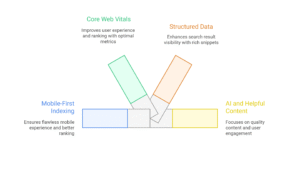
The SEO landscape is constantly evolving, and these free tools are keeping pace with the latest algorithm updates and ranking factors. Here’s what you should be paying attention to in 2025:
Mobile-First Indexing and Usability Tests
Google now uses the mobile version of your website for indexing and ranking. Tools like Google Search Console and GTmetrix help you ensure your mobile experience is flawless.
- Check mobile page speed separately from desktop
- Ensure buttons and links are easily tappable
- Verify that content is fully accessible on mobile devices
- Test mobile usability across different screen sizes
Core Web Vitals: The New Ranking Reality
Page experience signals are now official ranking factors. These metrics measure real user experience:
- Largest Contentful Paint (LCP): Should be under 2.5 seconds
- First Input Delay (FID): Should be under 100 milliseconds
- Cumulative Layout Shift (CLS): Should be under 0.1
GTmetrix and Google Search Console excel at tracking these metrics and providing actionable improvement suggestions.
Structured Data and Rich Snippets
Rich snippets are becoming increasingly important for standing out in search results. Tools like Sitechecker and Screaming Frog help identify structured data opportunities:
- Product markup for e-commerce sites
- Recipe markup for food blogs
- FAQ markup for service pages
- Review markup for local businesses
Preparing for AI and Helpful Content Updates
Google’s focus on helpful, people-first content means you need to audit your content quality regularly:
- Identify thin or low-quality content pages
- Find opportunities to add more value and depth
- Ensure content matches search intent
- Monitor user engagement metrics
Bonus: Recommended Tool Combinations for Every Scenario
While each tool has its strengths, combining them gives you a complete picture of your SEO health. Here are my recommended setups for different situations:
For Complete Beginners
Primary tool: Google Search Console
Why: It’s free, authoritative, and relatively easy to understand. Start here to get familiar with SEO concepts.
Monthly addition: SEOptimer for simple audits and actionable recommendations.
For Bloggers and Content Creators
Primary combo: SEOptimer + GTmetrix
Why: SEOptimer handles on-page SEO and content optimization, while GTmetrix ensures your site loads quickly for readers.
Advanced addition: Google Search Console for keyword insights and content performance tracking.
For E-commerce Sites
Power combo: Ahrefs Webmaster Tools + Screaming Frog
Why: E-commerce sites have complex structures with hundreds or thousands of pages. These tools excel at finding technical issues and broken links that hurt conversions.
Speed monitoring: Add GTmetrix for Core Web Vitals tracking, especially important for product pages.
For Digital Agencies
Client presentation combo: Woorank + Sitechecker
Why: Both tools create visually appealing reports that are easy to present to clients. They provide comprehensive analysis without overwhelming non-technical stakeholders.
Technical deep-dive: Add Screaming Frog for detailed technical audits and Google Search Console for official Google data.
For Local Businesses
Essential trio: Google Search Console + SEOptimer + GTmetrix
Why: Local businesses need to focus on basics – making sure Google can find and index their site, optimizing for local search terms, and ensuring fast loading for mobile users.
Common Mistakes to Avoid When Using Free SEO Audit Tools
After helping hundreds of website owners with their SEO audits, I’ve seen the same mistakes over and over. Here’s how to avoid them:
Mistake 1: Trying to Fix Everything at Once
I get it – when you see a list of 50+ issues, you want to tackle them all immediately. But this approach usually leads to overwhelm and incomplete fixes.
Better approach: Focus on 3-5 high-impact issues per week. Complete them properly before moving to the next batch.
Mistake 2: Ignoring Mobile Performance
Many people test their site on desktop and assume mobile will be fine. With mobile-first indexing, this is a costly mistake.
Better approach: Always test mobile performance separately. Most of your visitors (and Google) are mobile-first.
Mistake 3: Not Tracking Changes Over Time
Running one audit and never following up is like going to the gym once and expecting to get fit.
Better approach: Set calendar reminders for monthly audits. Track your progress with screenshots and exported reports.
Mistake 4: Focusing Only on Technical Issues
Technical SEO is important, but don’t neglect content quality and user experience.
Better approach: Balance technical fixes with content improvements and user experience enhancements.
Final Thoughts
Here’s the truth that many SEO experts won’t tell you: you don’t need to spend hundreds of dollars on premium tools to dramatically improve your website’s SEO performance. The free tools covered in this guide are powerful enough to help you identify and fix the majority of issues that are holding your site back.
I’ve seen small businesses increase their organic traffic by 200-300% using nothing but the free tools mentioned in this guide. The key isn’t having access to the most expensive tools – it’s about using the right tools consistently and taking action on what you discover.
Start with Google Search Console to get the basics right, then gradually add other tools as you become more comfortable with SEO concepts. Remember, the best SEO strategy is the one you actually implement.


